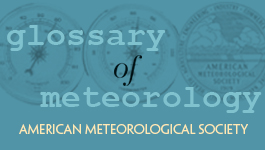In 2006, the National Centers for Environmental Prediction (NCEP) implemented the Real-Time Mesoscale Analysis (RTMA) in collaboration with the Earth System Research Laboratory and the National Environmental, Satellite, and Data Information Service (NESDIS). In this work, a description of the RTMA applied to the 5-km resolution conterminous U.S. grid of the National Digital Forecast Database is given. Its two-dimensional variational data assimilation (2DVAR) component used to analyze near-surface observations is described in detail, and a brief discussion of the remapping of the NCEP stage II quantitative precipitation amount and NESDIS Geostationary Operational Environmental Satellite (GOES) sounder effective cloud amount to the 5-km grid is offered. Terrain-following background error covariances are used with the 2DVAR approach, which produces gridded fields of 2-m temperature, 2-m specific humidity, 2-m dewpoint, 10-m U and V wind components, and surface pressure. The estimate of the analysis uncertainty via the Lanczos method is briefly described. The strength of the 2DVAR is illustrated by (i) its ability to analyze a June 2007 cold temperature pool over the Washington, D.C., area; (ii) its fairly good analysis of a December 2008 mid-Atlantic region high-wind event that started from a very weak first guess; and (iii) its successful recovery of the finescale moisture features in a January 2010 case study over southern California. According to a cross-validation analysis for a 15-day period during November 2009, root-mean-square error improvements over the first guess range from 16% for wind speed to 45% for specific humidity.
 The Real-Time Mesoscale Analysis at NOAA’s National Centers for Environmental Prediction: Current Status and Development
The Real-Time Mesoscale Analysis at NOAA’s National Centers for Environmental Prediction: Current Status and Development
Authors:
Manuel S. F. V. De Pondeca*, Geoffrey S. Manikin+, Geoff DiMego+, Stanley G. Benjamin#, David F. Parrish+, R. James Purser*, Wan-Shu Wu+, John D. Horel@, David T. Myrick&, Ying Lin+, Robert M. Aune**, Dennis Keyser+, Brad Colman++, Greg Mann##, and Jamie Vavra@@Affiliations* IMSG, Washington, D.C., and NOAA/NWS/NCEP/EMC, Camp Springs, MarylandAffiliations
+ NOAA/NWS/NCEP/EMC, Camp Springs, MarylandAffiliations
# NOAA/NWS/ESRL/GSD, Boulder, ColoradoAffiliations
@ University of Utah, Salt Lake City, UtahAffiliations
& NOAA/NWS/Western Region Headquarters, Salt Lake City, UtahAffiliations
** CIMSS, University of Wisconsin—Madison, Madison, WisconsinAffiliations
++ NOAA/NWS, Seattle, WashingtonAffiliations
## NOAA/NWS, Detroit, MichiganAffiliations
@@ NOAA/NWS/OST, Silver Spring, Maryland
Received: 21 October 2010
Final Form: 1 April 2011
Published Online: 1 October 2011
October 2011


Share this Article
Featured Collections
Mountain Terrain Atmospheric Modeling and Observations (MATERHORN) -BAMS, JAMC,MWR, WAF
LatMix -BAMS, JPO, JTECH
PANDOWAE -MWR, JAS, WAF, JTECH
Most Read WAF Articles
(past 12 months)
| . |
Sanders et al.
August 2016, Vol. 31, No. 4
|
| . |
Otsuka et al.
October 2016, Vol. 31, No. 5
|
| . |
Herman et al.
April 2016, Vol. 31, No. 2
|
| . |
Dong et al.
February 2016, Vol. 31, No. 1
|
| . |
Gallo et al.
February 2016, Vol. 31, No. 1
|
| . |
Apsley et al.
June 2016, Vol. 31, No. 3
|
Most Cited (past 12 months)
-
1. Flash Flood Forecasting: An Ingredients-Based MethodologyDoswell et al.December 1996, Vol. 11, No. 4 -
2. Decomposition of the Continuous Ranked Probability Score for Ensemble Prediction SystemsHersbachOctober 2000, Vol. 15, No. 5 -
3. Large-Scale Characteristics of Rapidly Intensifying Tropical Cyclones in the North Atlantic BasinKaplan et al.December 2003, Vol. 18, No. 6 -
4. The WSR-88D Rainfall AlgorithmFulton et al.June 1998, Vol. 13, No. 2 -
5. Revision of Convection and Vertical Diffusion Schemes in the NCEP Global Forecast SystemHan et al.August 2011, Vol. 26, No. 4 -
6. The Hydrometeor Classification Algorithm for the Polarimetric WSR-88D: Description and Application to an MCSPark et al.June 2009, Vol. 24, No. 3



